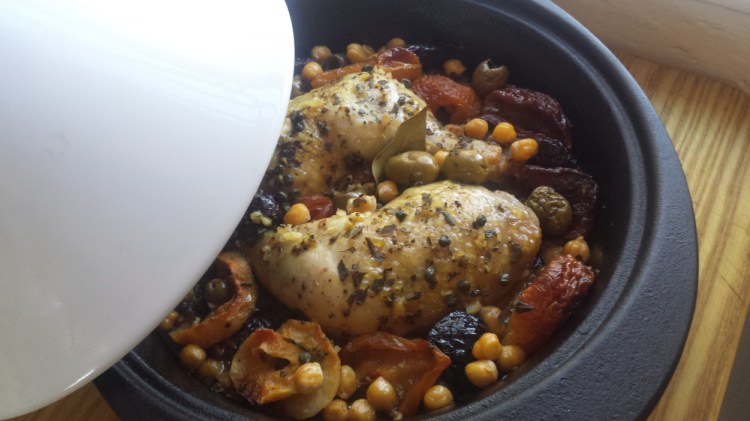Brunswick resident Carmen Greenlee fantasizes about paring down her belongings to live in a tiny house. She’s not sure of the location yet, but in her fantasy, the plot of land upon which it will sit will be wooded for privacy, but not too densely wooded, because the sun will need to flow easily through south-facing, floor-to-ceiling windows. And sitting on the small stove top in Greenlee’s tiny house, will be her “desert island” piece of cookware, a sleek-lined, cast iron-bottomed and ceramic-topped tagine.
A tagine is a North African earthenware cooking pot comprising a 2-inch deep, round base and a conical lid. It’s traditionally used to make flavorful stews that go by the same name.
Establishing a “desert island” anything – music, food, books, cookware, clothing – is a mental exercise that lets consumers ruminate on minimalist collections of what they’d want to listen to, eat, wear or read over and over again if they were stranded on a desert island. It’s also a lesson that can recalibrate a mindset (and possibly a lifestyle) away from consumerism towards sustainable acquisition practices.
Greenlee is a reformed cooking gadget hoarder. Until she renovated her postwar Cape in 2013, her kitchen was outfitted with everything from a pierogi press and marrow spoons to a chinois (an expensive, fine-meshed, pointed strainer used to make bisque) and baguette baking racks.
In the course of the remodeling, she got rid of extraneous, single-purpose cooking apparatus, but agreed to take in a 9½-inch tagine made by Beka Cookware, a hand-me-down from a friend who was also de-cluttering his kitchen in preparation for a long-distance move. He convinced her it would look fantastic sitting on the stove in her new, modern kitchen.
Greenlee, a style maven, admits to being drawn to the vessel’s looks. But being a librarian, she reached for a copy of Paula Wolfert’s “The Food of Morocco” to learn how to use it to make Berber tagines.
Greenlee came to love a variety of these richly flavored stews (see recipe), but found she was also reaching for the tagine often to cook other foods in other ways. She is now hard-pressed to think of many culinary duties it can’t handle, either on the stove top (over gas, electric and induction heat) or in the oven.
She can braise, bake, fry and poach in it; and use it as a bain-marie, a pancake griddle, a casserole pan or a table-worthy serving dish. The straight sides make it perfect for baking cornbread, single-layer cakes and even no-knead bread. And since by design its shape helps recirculate evaporating moisture, she can use it to warm up leftovers, too.
“I could get rid of almost everything else,” Greenlee said.
If you consider the per-use cost, the tagine’s $120 price tag is a bargain (although admittedly, getting a hand-me-down from a friend can’t be beat). And Greenlee says it makes a perfect wedding gift and is available online from several companies or from local cookware shops. No, she’s not moonlighting as a Beka Cookware saleswoman, she’s simply amazed and pleased at how this perpetually repurposed piece of cookware has changed how she cooks.
CARMEN’S CHICKEN MARBELLA TAGINE
Chicken Marbella, from “The Silver Palate Cookbook,” was a go-to dinner party meal for Carmen Greenlee’s mother, Antonia Castillo Mattei (and just about every other hostess in the 1980s). Mattei elevated the dish’s tableside cachet with whole Cornish game hens and white raisins, dried figs and dried apricots. Her daughter has adapted the recipe to feature either dark meat chicken quarters or pork tenderloin. If you don’t own a tagine, this dish can easily be made in a 12-inch cast iron skillet with a cover or a 13-by-9-inch ceramic baking dish with some aluminum foil.
Serves 4
4 chicken leg and thigh quarters
1 cup mixed dried fruit (prunes, apricots, raisins, apples, etc.)
1/4 cup olive oil
1/4 cup red wine vinegar
1/4 cup pitted Spanish green olives with 1 tablespoon juice
2 tablespoons capers with 1 teaspoon of juice
6 garlic cloves, minced
1 tablespoon dried oregano
½ teaspoon coarse salt
½ teaspoon freshly ground black pepper
2 bay leaves
1 cup cooked chickpeas
1/4 cup brown sugar
3/4 cup white wine
2 tablespoons finely chopped Italian parsley or cilantro
In a large bowl, combine the chicken quarters, dried fruit, oil, vinegar, olives and juice, capers and juice, garlic, oregano, salt and pepper, and bay leaves. Cover and marinate, refrigerated, overnight.
Preheat the oven to 350 degrees F.
Arrange chicken and chickpeas in a single layer in the bottom of a tagine. Spoon marinade evenly over the top of the chicken. Sprinkle chicken pieces with brown sugar and pour wine around them.
Place the cover on the tagine and bake for 50 minutes to 1 hour. (If not using a tagine, baste the chicken often.) Remove tagine cover for last 15 minutes of cooking, basting 2 or 3 times in that period. Chicken is done when thigh pieces, pricked with a fork at their thickest, yield clear yellow (rather than pink) juice. Serve chicken warm or room temperature, garnished with parsley or cilantro.
Send questions/comments to the editors.



Success. Please wait for the page to reload. If the page does not reload within 5 seconds, please refresh the page.
Enter your email and password to access comments.
Hi, to comment on stories you must . This profile is in addition to your subscription and website login.
Already have a commenting profile? .
Invalid username/password.
Please check your email to confirm and complete your registration.
Only subscribers are eligible to post comments. Please subscribe or login first for digital access. Here’s why.
Use the form below to reset your password. When you've submitted your account email, we will send an email with a reset code.